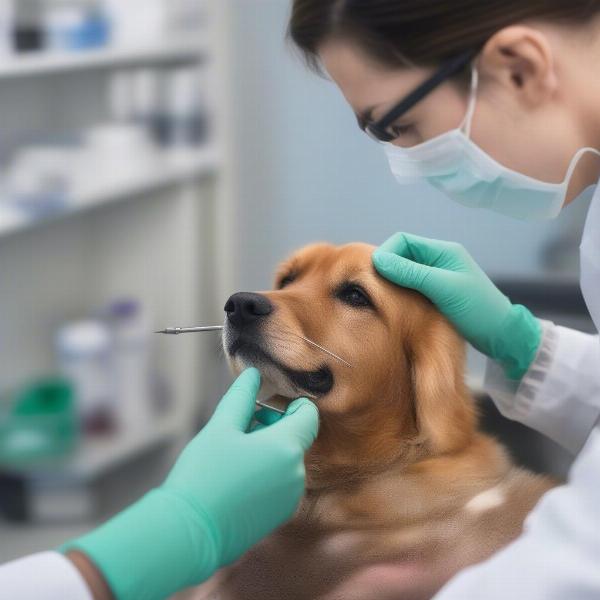Sebaceous gland tumors dog pictures can be alarming for any pet owner. These growths, arising from the sebaceous glands that produce oil for skin and fur, can vary in appearance and raise concerns about your dog’s health. This article provides valuable information about identifying, diagnosing, and treating sebaceous gland tumors in dogs, empowering you to make informed decisions about your furry friend’s care.
Understanding Sebaceous Gland Tumors in Dogs
Sebaceous gland tumors are common skin tumors in dogs. While some are benign, others can be malignant and require prompt veterinary attention. Recognizing these tumors early on is key to ensuring the best possible outcome for your pet. Several types exist, including adenomas, epitheliomas, and adenocarcinomas. Differentiating between them based solely on sebaceous gland tumors dog pictures can be difficult, making professional diagnosis crucial.
What do sebaceous gland tumors look like in dogs? They often appear as small, raised nodules or warts, ranging in color from pink to gray or black. They can be single or multiple and may occur anywhere on the body, but common locations include the eyelids, head, limbs, and trunk. Some tumors may be hairless or ulcerated.
Diagnosing Sebaceous Gland Tumors
While sebaceous gland tumors dog pictures can offer a preliminary visual guide, a definitive diagnosis requires veterinary expertise. Your veterinarian will perform a thorough physical examination and may recommend further diagnostic tests, such as:
- Fine-needle aspiration: This involves collecting cells from the tumor using a small needle for microscopic examination.
- Biopsy: A small tissue sample is removed and analyzed to determine the tumor type and malignancy.
These diagnostic procedures are essential for accurate identification and treatment planning.
 Sebaceous Gland Tumor Biopsy Procedure
Sebaceous Gland Tumor Biopsy Procedure
Treatment Options for Sebaceous Gland Tumors
The appropriate treatment for a sebaceous gland tumor in dogs depends on several factors, including the tumor type, size, location, and the dog’s overall health. Treatment options may include:
- Surgical removal: This is the most common treatment for sebaceous gland tumors, particularly for benign growths. Complete surgical excision is often curative.
- Cryosurgery: This technique uses liquid nitrogen to freeze and destroy the tumor cells. It is often used for smaller, superficial lesions.
- Radiation therapy: This may be recommended for malignant tumors or tumors that cannot be surgically removed.
- Chemotherapy: This may be used in conjunction with surgery or radiation therapy for aggressive or metastatic tumors.
When to Seek Veterinary Attention
If you notice any unusual lumps, bumps, or growths on your dog’s skin, it’s crucial to consult a veterinarian promptly. Early diagnosis and treatment are essential for the best possible outcome. Don’t rely solely on sebaceous gland tumors dog pictures for diagnosis.
Conclusion
Sebaceous gland tumors in dogs require careful monitoring and veterinary attention. While sebaceous gland tumors dog pictures can help you recognize potential issues, a definitive diagnosis requires professional assessment. By seeking timely veterinary care and following the recommended treatment plan, you can help ensure your dog’s long-term health and well-being.
FAQ
- Are all sebaceous gland tumors cancerous? No, many are benign, but some can be malignant.
- Can sebaceous gland tumors be prevented? There’s no guaranteed way to prevent them, but regular skin checks can help with early detection.
- How much does it cost to remove a sebaceous gland tumor? The cost varies depending on the size, location, and complexity of the surgery.
- What is the recovery time after sebaceous gland tumor removal? Most dogs recover quickly, typically within a few weeks.
- Are there any home remedies for sebaceous gland tumors? No, it’s crucial to seek veterinary care for diagnosis and treatment.
- Can sebaceous gland tumors spread to other parts of the body? Malignant tumors can potentially metastasize.
- What is the prognosis for dogs with sebaceous gland tumors? The prognosis depends on the type and stage of the tumor.
About ILM Dog
ILM Dog (https://ilmdog.com) is your trusted international resource for comprehensive dog care and wellness. We offer expert advice on everything from breed selection and health care to training, nutrition, grooming, and product recommendations. We are dedicated to empowering dog owners worldwide with the knowledge and resources they need to provide the best possible care for their canine companions. Contact us today for all your dog-related inquiries: Email: [email protected], Phone: +44 20-3965-8624.